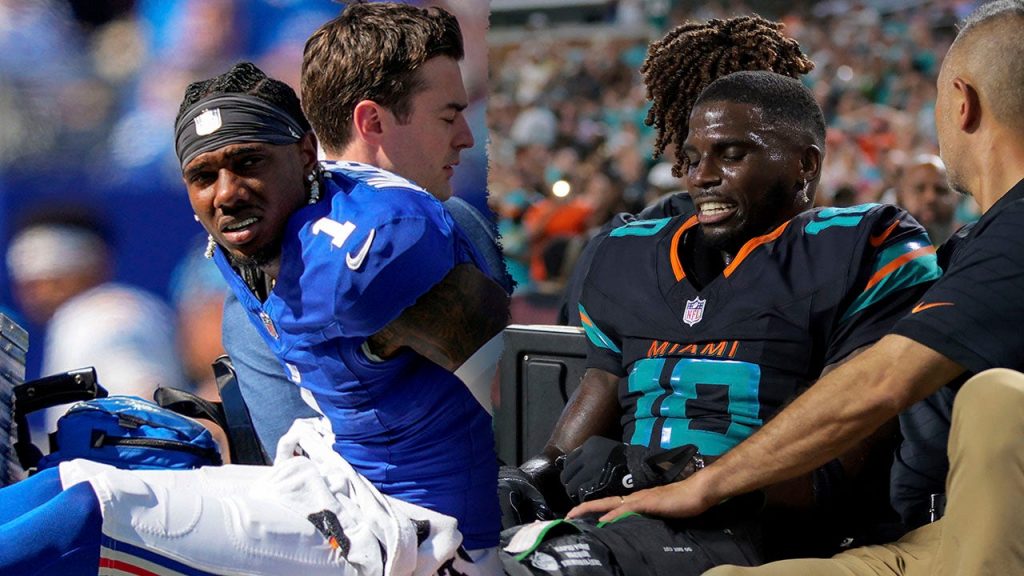NFL’s Field Surface Debate Continues as Injuries Mount
In the fourth week of the NFL season, the league witnessed a series of devastating injuries that reignited the ongoing debate about playing surfaces. Most notably, promising rookie Malik Nabers and star receiver Tyreek Hill both suffered torn ACLs, while other players like Trey Benson sustained knee injuries and Lamar Jackson experienced hamstring issues. Nabers’ injury occurred at MetLife Stadium, a venue with artificial turf that has gained notoriety for a string of serious injuries over recent seasons. The facility has been the site of multiple ACL and Achilles tears, raising concerns about player safety and the relationship between artificial surfaces and injury rates.
The NFL Players Association has been vocal in its push for all NFL stadiums to transition to natural grass playing surfaces, citing player preferences and safety concerns. According to NFLPA executive director Lloyd Howell, an overwhelming 92% of NFL players prefer playing on grass surfaces rather than artificial turf. Despite this strong player preference, half of the league’s 30 stadiums continue to use artificial turf, with many venues showing reluctance to make the switch. This divide between player preference and league implementation has become a point of tension as injuries continue to occur on both surfaces, though soft-tissue injuries have been more frequently associated with artificial playing surfaces.
Larry Fitzgerald, the legendary NFL receiver known for his remarkable durability throughout his 17-year career, offered a pragmatic perspective on the grass-versus-turf debate. In a recent interview with Fox News Digital, Fitzgerald expressed doubt about the feasibility of implementing grass fields across all NFL venues. “I don’t think it’s feasible in most places,” Fitzgerald explained. “MetLife Stadium is probably used 100 days a year, and only 20 of them are for football games. You’re hosting Bruce Springsteen concerts, monster truck rallies. I just don’t think grass would do well in that environment.” His comments highlight the practical challenges faced by multi-use stadiums that host numerous non-football events throughout the year.
While acknowledging the concerns about artificial turf, Fitzgerald also pointed to the inherent physical risks of professional football regardless of playing surface. “I was at the 49ers-Cardinals game, and I saw James Conner break his ankle on grass. I saw Nick Bosa blow his ACL on grass,” Fitzgerald noted. “When you have 300-pound people running into each other full-speed, these are strong, physical dudes. If they played in bubble wrap, guys would get hurt.” His observation provides important context to the debate, reminding fans and stakeholders that the high-impact nature of football itself contributes significantly to injury risk, regardless of the surface underfoot.
The complexity of the issue is further illustrated by examples that cut against typical narratives in the turf-versus-grass debate. While Nabers’ injury occurred on MetLife’s artificial turf, Tyreek Hill’s ACL tear happened on a grass field, suggesting that the tackling mechanics may have been more determinative than the surface itself. Similarly, Trey Benson’s injury requiring surgery occurred at State Farm Stadium, which features retractable natural grass—the same surface type where Fitzgerald spent his home games during his career with the Arizona Cardinals. These counterexamples complicate the straightforward narrative that grass is always safer than turf for NFL players.
As the NFL season progresses, the conversation about playing surfaces will likely continue, especially if high-profile injuries persist. The tension between player safety preferences and the practical realities of stadium management presents a significant challenge for the league and team owners. While the NFLPA continues to advocate strongly for natural grass based on player preference and injury data regarding soft-tissue injuries, venues must balance these concerns with the economic and logistical realities of maintaining natural surfaces in multi-use facilities. Meanwhile, players like Fitzgerald remind us that football’s physical nature means risk will always be present, regardless of the surface upon which the game is played.


